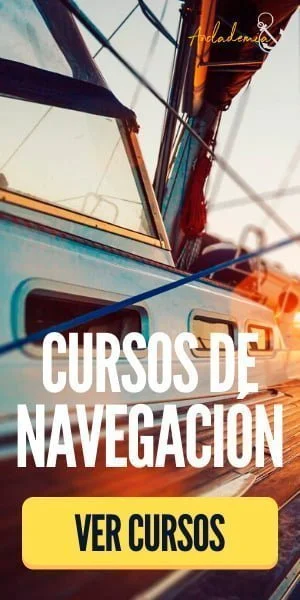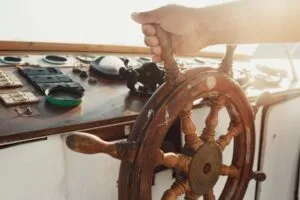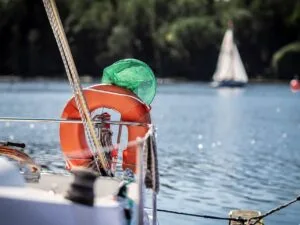Area of application
a) They must be fulfilled in all weather conditions.
b) The rules relating to lights must be met from sunset to sunrise, and during this interval NO other lights will be displayed that they can confuse them with those described in this Regulation, or that impair visibility or that prevent effective surveillance.
c) The lights of these rules They MUST also be displayed if there is REDUCED VISIBILITY, as well as in any circumstance deemed appropriate.
d) The marks must be met by DAY.
e) Both the lights and the markings must meet the specifications of the ANNEX I of this Regulation (separation, height, luminosity, etc.).
The lights and markings that ships display serve to others know your presence, know your adress and if they have or not some type of restriction for your maneuverability. This system cannot be replaced by another (for example VHF) except in case of force majeure.
These rules must be followed in any state of the weatheras long as you are not docked. The use of lights It is not prohibited during the day.
Definitions
to the "stop light" it's a light white placed on the longitudinal axis of the ship, which shows its light without interruption throughout a horizon arc of 225 degrees, set so that is visible from the bow to 22.5 degrees aft of the beam on each side of the vessel.
b) The "side lights" they are a light green on starboard side and a light red on the port side that each show its uninterrupted light over an entire horizon arc of 112.5 degrees, fixed so that they are visible from the bow to 22.5 degrees aft of the beam of their respective side. On the ships of length less than 20 meters, side lights They may be combined in a single lantern carried along the longitudinal axis of the ship..
c) The "range light" it's a light white placed as close to the stern as possible that shows your uninterrupted light over an entire 135-degree horizon arc, set so that is visible in an arc of 67.5 degrees, counted from the stern towards each side of the ship.
d) The "trailer light" is a yellow light with the same characteristics as the "range light" defined in paragraph c) of this Regulation. the A "light all horizon" It is a light that is visible without interruption over a 360-degree horizon arc.
f) The "sparkling light" It is a light that produces flashes at regular intervals, with a frequency of 120 or more flashes per minute.
Mechanically propelled vessels in navigation
a) Mechanically powered vessels in navigation will exhibit:
- a light of butt forward;
- A second masthead light, aft and higher than the bow, except for ships less than 50 meters in length, that they will have no obligation to exhibit this second light, although they may do so;
- Lights sideways;
- A light of scope.
b) The hovercraft, when operating in the non-displacement condition, they will exhibit, in addition to the lights prescribed in paragraph a) of this Rule, a light yellow sparkles all horizon.
c)
- Mechanically propelled vessels of less than 12 meters may display, in lieu of the lights prescribed in paragraph a) of this Rule, a light white all-round and side lights;
- Mechanically propelled vessels of less than seven meters and whose maximum speed does not exceed seven knots, may display, instead of the lights prescribed in paragraph a) of this Rule, a white light all horizon and it is possible, they will also display side lights;
- On mechanically propelled vessels of less than 12 meters, the light of top or white light all horizon will be able deviate from the longitudinal axis of the ship if it is not possible to place it on said axis, provided that that the side lights are combined into a single lantern, which will be carried in the longitudinal axis of the ship or placed as close as possible to the bow-stern line on which the masthead light or all-round white light goes..
Vessels towing and pushing
When one ship is towing another There are several signs that you should keep in mind and follow.
a) Every ship of mechanical propulsion when towing another it will display:
- Instead of the light prescribed in sections i) or ii) of Rule 23 a), two masthead lights in a vertical line. When the length of the trailer, measured from the stern of the towing vessel to the aft end of the trailer, be greater than 200 meters, will exhibit three lights from mast to bow, according to a vertical line;
- Lights of side stand;
- a light of scope;
- A light tow in a vertical line and above light range;
- A biconical mark in the most visible place when the length of the trailer is greater than 200 meters.
b) When a pushing vessel and a pushed vessel are joined by a rigid connection forming a composite unit, they will be considered as a mechanically powered vessel and shall display the lights prescribed in the Rule 23.
c) Any mechanically propelled vessel pushing forward or towing over the side will exhibit, except in the case of constituting a composite unit:
- In lieu of the light prescribed in paragraphs i) or ii) of Rule 23 a), two stop lights in a vertical line;
- Lights of side stand;
- a light of scope.
d) Mechanically powered vessels to which paragraphs a) or c) above apply, they will comply also with Rule 23 a) ii).
e) Everything vessel or towed object other than those mentioned in paragraph g) of this Rule will display:
- Lights of side stand;
- a light of scope;
- A biconical mark in the most visible place, when the length of the trailer is greater than 200 meters.
f) Taking into account that whatever the number of vessels that are tow over the side or push in a group, They will have to light up as if they were a single ship;
- A ship that is pushed forward, without forming a composite unit, will display side lights at the bow end; ii) A ship that When towed on the side, it will display a range light and side lights at the bow end..
g) Any vessel or towed object, inconspicuous and partially submerged and any combination of vessels or objects in which those same circumstances occur will display:
- When its width is less than 25 meters, a all-round white light at the bow end or near of this and another at or near the stern end, with the exception that the dragons will not have to display a light at or near the bow end;
- When its width is equal to or greater than 25 meters, two additional all-round white lights at the extreme points of that width or close to these;
- When its length is greater than 100 meters, additional all-round white lights between the lights prescribed in sections i) and ii) so that the distance between lights does not exceed 100 meters;
- A biconical mark at or near the after end of the last vessel or object being towed, and when the length of the tow is greater than 200 meters, an additional biconical mark in the most visible place and as close as possible to the forward end.
h) When, For some justified reason, it is not possible for the vessel or towed object to display the prescribed lights or markings. in paragraphs e) or g) of this
Rule, all possible measures will be taken to illuminate the vessel or towed object, or for indicate at least the presence of said vessel or object.
i) When, for any justified reason, it is impossible for a vessel not normally engaged in towing operations to display the lights prescribed in paragraphs a) or c) of this Rule, such vessel shall not be required to display such lights when towing another vessel that is in distress or otherwise in need of assistance.. All possible measures shall be taken to indicate the nature of the connection between the towing vessel and the towed vessel, as authorized in Rule 36, in particular by illuminating the towline.
Are you interested in: Course and steering rules
Sailing ships and rowing boats
a) Vessels sailing in navigation will exhibit:
- Lights of side stand;
- a light of scope.
b) On sailing ships length less than "20 meters" the lights prescribed in paragraph a) of this Rule may go on a combo bluff, which will be carried in the top of the stick or near it, in the most visible place.
c) In addition to the lights prescribed in paragraph a) of this Rule, sailing vessels in navigation They may display at the top of the mast or near it, in the most visible place, two all-round lights in a vertical line, the upper one red and the lower one green., but these lights will not be displayed together with the combined lantern permitted in paragraph b) of this Rule.
d)
- Sailing boats of length less than 7 meters will display, if possible, the lights prescribed in paragraph a) or b), but if they do not They must have on hand for immediate use an electric flashlight or lighted lantern that shows a white light, which will be displayed in sufficient time to avoid collision..
- The vessels of Oars may display the lights prescribed in this Rule for sailing vessels, but if they do not do so they must have on hand for immediate use an electric flashlight or lighted lantern showing a white light, which will be displayed in sufficient time to prevent collision..
e) A ship that sails, when it is also mechanically propelled, must display on the bow, in the most visible place, a conical mark with the apex downwards.
fishing vessels
a) The ships dedicated to fishing, are already in navigation either anchored, or will exhibit only the markings and lights prescribed in this rule.
b) Ships dedicated to trawling (towing nets or other fishing gear through the water) will display:
- Two all-round lights in a vertical line, green on top and white on bottom, or a brand of two cones joined by their vertices in a vertical line.
- a light of butt aft higher than the green all horizons, except those of less than 50 meters that they will not have to carry it, although they can do so.
- when they go with startIn addition to the previous ones, lights sides and the light of scope.
c) Vessels dedicated to fishing that are not drag, will exhibit:
- Two all-round lights in a vertical line, red the top and white the bottom, or a brand of two cones joined by their vertices in a vertical line.
- When the rig launched a white light extends more than 150 meters all around the horizon, or a cone with apex facing up, in the direction of the rig.
- when they go with startIn addition to the previous ones, lights sides and the light of scope.
d) The additional signs prescribed in ANNEX II will apply to all vessels engaged in fishing.
e) When they are not dedicated to fishing They will only use those prescribed for ships of the same length.
Vessels without steering or with restricted maneuverability
a) The ships no government will exhibit:
- Two all-round red lights in a vertical line, in the most visible place;
- Two balls or similar marks in a vertical line, in the most visible place;
- when they go with start, in addition to the lights prescribed in this paragraph, side lights and a scope light.
b) Vessels that have their restricted maneuverability, except those dedicated to mine clearance operations, will display:
- Three all-round lights in a vertical line, in the most visible place. The highest and lowest of these lights will be red and the center light will be white;
- Three marks in a vertical line in the most visible place.
The highest and lowest of these marks will be balls and the central mark will be biconical; - when they go with start, in addition to the lights prescribed in section i), one or more stop lights, side lights and a range light; iv. when are anchored, in addition to the lights or marks prescribed in sections i) and ii) the lights or marks prescribed in the Rule 30.
c) Mechanically powered vessels dedicated to a towing operation that externally restricts both the capacity of the towing vessel and its tow To turn away from their defeat they will display, in addition to the lights or marks prescribed in Rule 24 a), the lights or marks prescribed in paragraphs b) i) and b) ii) of this Rule.
d) Vessels dedicated to dredging operations or submarines that have restricted maneuverability shall display the lights and markings prescribed in sections i), ii) and iii) of paragraph b) of this Rule and, when there is an obstruction, they will also exhibit:
- Two all-round red lights or two balls in a vertical line to indicate the band along which the obstruction is located;
- Two all-round green lights or two biconical marks in a vertical line to indicate the band through which it can pass another ship;
- When they are at anchor, the lights or marks prescribed in this paragraph in lieu of the lights or marks prescribed in Rule 30.
e) When due to the dimensions of the vessel dedicated to diving operations it turns out impossible to display all the lights and marks prescribed in paragraph d) of this Rule, will be displayed:
- Three all-round lights in a vertical line, in the most visible place. The highest and lowest of those lights will be red and the center light will be white;
- A reproduction in rigid material and no less than one meter high of flag "A" of the International Code. Measures will be taken to guarantee its visibility throughout the horizon.
f) Ships dedicated to mine clearance operations, in addition to the lights prescribed for mechanically powered vessels in the Rule 23 or of the lights or marks prescribed in Rule 30 for ships at anchor, as appropriate, will display three all-round green lights or three balls. One of these lights or marks will be displayed on the upper part of the most forward mast and the other two on each of the yardarms of said mast. These lights or marks indicate that It is dangerous for another ship to approach less than 1000 meters from the stern of the ship dedicated to mine clearance.
g) Vessels less than 12 meters in length, except those dedicated to diving operations, will not be required to display the prescribed lights and markings. in this Rule.
h) The signals prescribed in this Rule are not signals of ships in distress needing help. These signs are found in Annex IV of this Regulation.
Mechanically powered vessels restricted by their draft
In addition to the lights prescribed in Rule 23 For mechanically powered vessels, any vessel restricted by its draft may display in the most visible place, three red lights all horizon in a vertical line, or a cylinder.
Pilot boats
a) The boats in service pilotage will exhibit:
- At or near the top of the stick, two all-round lights in a vertical line, the upper one being white and the lower one red;
- When they meet in navigation, in addition, the side lights and a range light;
- When they are anchored, in addition to the lights prescribed in section i), the light or lights or marks prescribed in Rule 30 for anchored vessels.
b) When not on pilotage duty, the pilot's vessel will display the lights or markings prescribed for vessels of the same length.
Anchored ships and stranded ships
a) The ships anchored will display in the most visible place:
- In the part of bow, an all-round white light or a ball;
- In the stern, or near it, and at a height lower than that of the light prescribed in section I), a light white all horizon.
b) Ships of less than 50 meters in length may display an all-round white light in the most visible place., instead of the lights prescribed in paragraph a) of this Rule.
c) Vessels at anchor may Use your work lights or equivalent to illuminate your decks. On ships of 100 meters in length or more, the use of the aforementioned lights will be mandatory.
d) In addition to the lights prescribed in paragraphs a) or b) of this Rule, A stranded ship will display, in the most visible place:
- Two all-round red lights in a vertical line;
- Three balls in a vertical line.
e) The boats less than 7 meters in length when they are anchored in a place that is not in or near a narrow canal, pass, anchorage or area of frequent navigation, They will not be obliged to display the lights or marks prescribed in paragraphs a) and b) of this Rule.
f) Vessels less than 12 meters in length, when stranded, they will not have the obligation to display the prescribed lights or marks in sections I) and II) of paragraph d) of this Rule.
Seaplanes
When to a seaplane may not be able to display lights and markings of the characteristics or in the prescribed positions in the Rules of this Part, It will display lights and marks that are as similar as possible, due to their characteristics and location.





